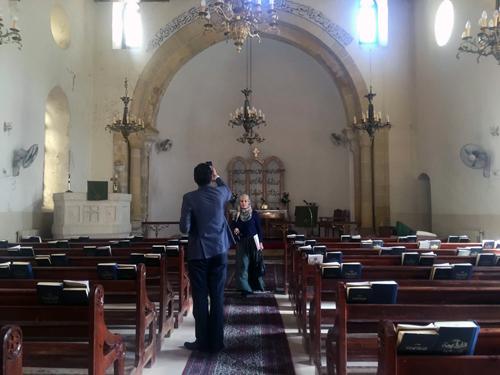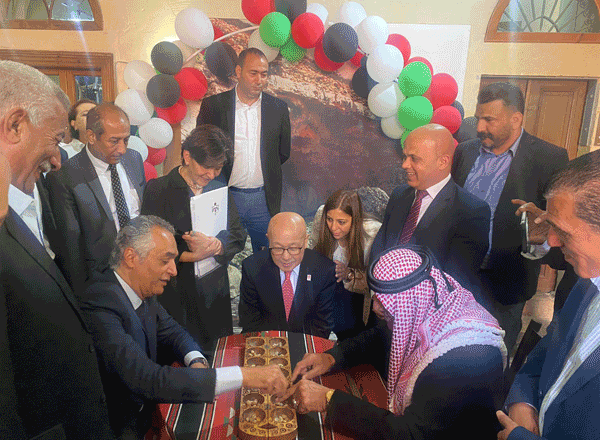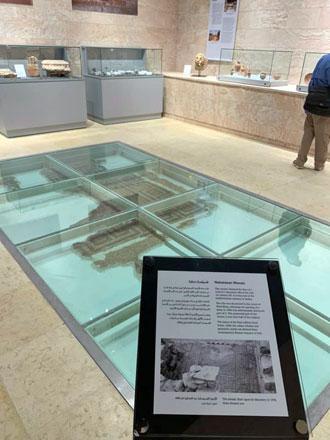You are here
JICA supporting 'eco-museum' in Salt to showcase daily life, traditions
By Suzanna Goussous - Mar 07,2016 - Last updated at Mar 07,2016

Media representatives take photos of a church in Salt during a press tour, on Sunday (Photo by Suzanna Goussous)
SALT — The Japan International Cooperation Agency (JICA) is funding a programme to promote tourism in Balqa's Salt city, some 35km northwest of Amman, by focusing on the daily life and traditions of residents through the concept of the “eco-museum”.
JICA, in cooperation with Salt Development Corporation, the Tourism Ministry and Salt Municipality is implementing the project to replicate the experience of the Japanese cities of Nagasaki and Hagi.
Motoaki Jo, from JICA’s tourism marketing department, said during a tour of Salt on Sunday that by utilising the city’s local resources, the eco-museum promotes other places like the mosque and church and also popular shops in the area.
Eco-museums are open-air museums that enable visitors to visit houses that represent certain traditions or eras, with residents dressed in costumes reflecting that and serving food typical of the era or tradition in question.
The concept was introduced to Japan in the 1980s, focusing on depicting rural life, according to web sources.
The JICA official told The Jordan Times that local residents are involved in organising the home-visit experience, where the mother cooks traditional food for visitors, who can also enrich their experience by wearing traditional clothes.
The next steps entail involving travel agencies and the shops in the old souk in the project. "Those kinds of shops have a unique history,” he said.
Salt, the official said, is beautiful with its historical buildings, and it offers many stories and traditions.
Authorities in Salt are seeking a place on the UNESCO World Heritage List, selecting 25 buildings that illustrate the "golden age" of the city between 1865 and 1920.
Kayo Murakami, assistant professor at Hokkaido University and a member of JICA’s eco-museum cultural department, said the daily life of Salt residents is highlighted through this project.
“We focus on [showcasing] buildings, agriculture [and] daily life. We visit the souk and houses and we ask them what kind of things you want to explain to tourists in your city,” Murakami told The Jordan Times.
She said 140 people were asked which aspects they would like to be highlighted, and the residents said they wanted to talk more about the harmony between Muslims and Christians, the first school in Salt and the souk.
Salt Development Corporation Director Khaldoun Khreisat said the idea for the project came from JICA, whose officials saw Salt as a similar model to the Japanese city of Hagi.
The assistance from JICA includes technical support and holding training programmes for Jordanians. Eight Jordanian tour guides were given English language courses and history classes to promote the city.
Khreisat said the programme, since 2012, has helped the corporation raise local community awareness by holding several workshops and offering historical, coexistence and educational courses.
He told The Jordan Times that a Japanese grant to the city was utilised to renovate sites before launching the eco-museum. “The Japanese grant is currently used to train tour guides and residents on how to receive tourists and promote their city’s sites and local products.”
“With this programme ... many women living here host groups during their tour around the city and make them lunch," Khreisat noted.
Japanese Ambassador to Jordan Shuichi Sakurai told reporters that the city of Salt reminds him of an old city in Japan.
“I feel nostalgic to Nagasaki when I visit Salt city,” he said. “The Buddhist temples, churches, and Japanese temples coexist just like churches and mosques do in Salt. The atmosphere is very similar in general.”
The press tour included a visit to Zai Water Treatment Plant, “where JICA supported Jordan with water infrastructure projects and capacity development projects for water engineers”, Shokichi Sakata, chief representative at JICA, said.
“The first phase dealt with renewing four deteriorated pumping stations and the second phase expanded four others in [the] Zai conveyance system and increased the capacity of the water supply from 45 million cubic metres to around 90 million cubic metres,” Sakata said.
Related Articles
SALT — The Japan International Cooperation Agency (JACA), in collaboration with the Ministry of Tourism and Antiquities, inaugurated a photo
AMMAN — Together with the Amman Chamber of Industry (ACI) and the Ministry of Industry, Trade and Supply, the Japan International Cooperatio
AMMAN — A mobile application of the Petra Museum is now available on both GooglePlay Store and the App Store.The Petra Museum Application na














